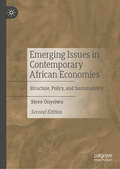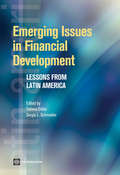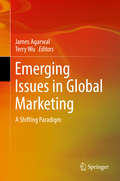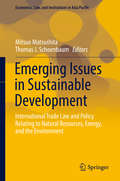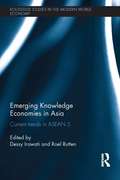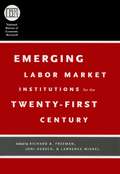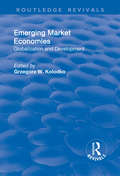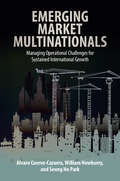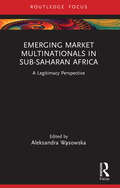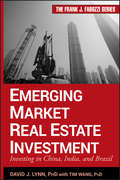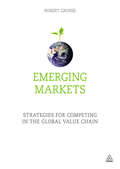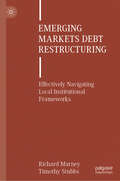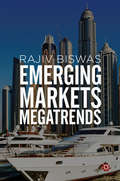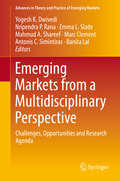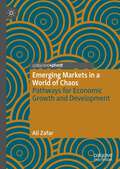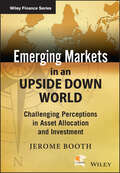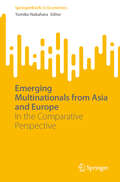- Table View
- List View
Emerging Issues in Contemporary African Economies: Structure, Policy, and Sustainability
by Steve OnyeiwuHow have the events of the twenty-first century shaped African economies and societies? In this book, Steve Onyeiwu highlights the dynamics, challenges, and opportunities in African economies. He analyzes the socioeconomic and political conditions in Africa, with emphasis on events of the past two decades. Onyeiwu notes that African economies change virtually every minute, and it’s imperative to ensure the information presented is current and accurate. Climate change and the explosion of the youth population have assumed new dimensions, prompting analysts to ponder their implications for the future of African economies. Other significant changes include COVID-19 and recent apprehension about the resilience of democracy throughout the region. The author addresses these complex topics and explains how the skepticism about the endurance of democracy is fueled by economic anxiety, political violence, coup d'états and protests in many parts of Africa. The book includes recent data on key variables and events in the region. In addition to undertaking thorough revisions of the 10 chapters from the first edition, this new edition includes three new chapters on population and youth, COVID-19, and climate change.
Emerging Issues in Financial Development: Lessons from Latin America
by Sergio L. Schmukler Tatiana DidierSince the 1990s, the financial systems in developing and developed countries have gained in soundness, depth, and diversity, prompted in part by a series of financial sector and macroeconomic reforms aimed at fostering a market-driven economy in which finance plays a central role. Latin America has been one of the regions at the forefront of these changes and offers a good laboratory of where the challenges in financial development lie. Despite all the gains in financial development, there is still a nagging contrast between the intensity of financial sector reforms implemented over the past 20 years in many countries and the actual size and depth of their financial systems. In the case of Latin America, in many respects it remains underdeveloped by international comparisons. This book studies in detail the recent history of financial sector development and reforms in Latin America, in comparison to other developing and developed countries, to shed light on the key obstacles for financial development. Rather than going in detail into sector-specific issues, the book focuses on the main architectural issues, overall perspectives, and interconnections. Its value added thus hinges on its holistic view of the development process, its broad coverage of the financial services industry (not just banking), its emphasis on comparisons and benchmarking, its systemic perspective, and its explicit effort to incorporate the lessons from the recent global financial crisis. The book is divided into three main parts. The first presents a stock taking exercise to ascertain where Latin America's financial development lies--analyzing in more detail some of the reasons and policy implications underlying its banking depth and equity liquidity gaps. The second part revisits two themes that are central to the region's financial development: long-term finance and the role of the state in risk bearing. The last part of the book deals with issues of regulation and supervision, first taking stock of the progress in the region and then analyzing the challenges faced by Latin America as regards three main facets of systemic oversight: macro-prudential policy, micro-systemic regulation, and systemic supervision. The chapters in this book yield many lessons and raise several issues, constituting an invaluable read for practitioners, policymakers, experts, and students alike in both developed and developing countries.
Emerging Issues in Global Marketing: A Shifting Paradigm
by Terry Wu James AgarwalThis book examines emerging theories, frameworks, and applications of global marketing for the 21st century. It highlights how global marketing is changing in a globalized and digital economy that is fast increasing in complexity and uncertainty. The traditional approach to global marketing is no longer sufficient to address the emerging issues in global markets. Global companies need to challenge traditional assumptions in global marketing in an era of shifting political, cultural, economic, and technological changes. They need to take a fresh look at the contemporary threats and opportunities in markets, institutions, and technology and how they affect entry and expansion strategies through careful re-calibration of the marketing-mix. This book offers new insights for global marketing that addresses these issues. This book should be an ideal resource to both academic scholars and reflective practitioners globally such as CEOs and chief marketing officers as well as government officials and policy makers interested in formulating strategies/policies for global marketing activities in the face of a globalized and digitized economy. This well-crafted research volume is an excellent addition to the growing literature on new trends in international marketing. The authors present the latest insight on the impact of phenomena such as cross-border e-commerce and digital markets, and they discuss new tools for political risk assessment, international branding and more broadly the reconfiguring of marketing-mix strategies – A powerful reminder that the new global market remains a rugged landscape. - Alain Verbeke, McCaig Research Chair in Management and Editor-in-Chief Journal of International Business Studies, University of Calgary, Canada. Emerging trends in institutions, markets, and societies, along with new technological advances, are redefining the scope and strategy in global marketing. Professors Agarwal and Wu have assembled a remarkable collection of cutting-edge topics and issues that capture the shifting paradigm and contemporary developments in the global marketing field. This is an informative and timely resource that makes a valuable contribution, useful for both scholars and business practitioners of global marketing. - Constantine S. Katsikeas, Arnold Ziff Endowed Research Chair in Marketing & International Management, Editor-in-Chief Journal of International Marketing, University of Leeds, UK. This book presents new and cutting-edge thinking at a time when the traditional views of international marketing need to be scrapped. Convergence forces are creating new opportunities as well as threats on a daily basis, and marketing practitioners as well as scholars must be forewarned as well as forearmed on how to deal with these changes. The real growth is coming from the emerging nations, and the theories that provided sufficient insights ten years ago have been completely outmoded by the ever-accelerating rate of innovation and technological change as well as the pressures to address the needs of all of the firm’s relevant stakeholders. The strategic insights provided here are absolutely invaluable. Don’t miss an opportunity to read this book!! - John B. Ford, Professor of Marketing & International Business, Eminent Scholar & Haislip-Rohrer Fellow, Editor-in-Chief, Journal of Advertising Research, Old Dominion University, USA.
Emerging Issues in Sustainable Development
by Mitsuo Matsushita Thomas J. SchoenbaumThis book seeks to answer the questions: how do the rules of international treaties on trade and investment apply to the new laws and policies relating to energy-related trade, and do the rules of the multilateral system contribute to or detract from sustainable development? An emerging set of new problems in the law of international trade is how to reconcile the rules of the multilateral trading system with shortages of certain natural resources and the necessity to develop renewable energy resources. The chapters in this book provide a comprehensive analysis of the international trade issues presented by national trade laws and policies with regard to natural resources and energy. This book is about the extent to which we are interpreting existing rules to cover emerging problems and how the rules of the multilateral trading system can be adapted to achieve sustainable development in natural resources and energy. The book begins with a survey of selected national laws relating to recent restrictions on the export of natural resources, both resources used to produce energy as well as natural resources essential for industrial production. After examining the range of such laws in selected important countries, we turn to the application of the rules of the multilateral trading system to such export restrictions. We discuss the major rules of the World Trade Organization (WTO) as well as the natural resources rules in selected regional preferential free trade agreements. While there is not a comprehensive global legal regime on competition law, we believe it is also important to examine how selected national competition laws impact export restrictions on natural resources. This book will be a major contribution to the international dialogue on international economic law issues with respect to trade in natural resources and energy.
Emerging Knowledge Economies in Asia: Current Trends in ASEAN-5 (Routledge Studies in the Modern World Economy)
by Roel Rutten Dessy IrawatiThe book aims to identify key issues and developments in ASEAN-5 that illustrate the transition of this region towards a knowledge-based economy. The book contributes to understanding the opportunities and challenges faced by emerging economies. It explains the transition process from a knowledge based perspective, showing how knowledge creation and innovation contribute to the competitiveness of companies and sectors in this region. The book takes a distinctly ASEAN perspective by discussing examples of the transition process from all ASEAN 5 nations that show how this region is attempting to link up to the global knowledge economy of the 21st Century. To achieve these aims the book is divided into three parts, preceded by an introductory chapter explaining the logic, objectives and contributions of the book. Part I discusses ASEAN-5 as an emerging hub in the global economy. Part II discusses the global links of the ASEAN region. Part III highlights innovation support in the ASEAN region. Each part identifies key developments and discusses relevant challenges and opportunities regarding the economic transition process based on examples for the various ASEAN-5 nations. The book contributes to the literature on emerging economies by explaining their challenges and opportunities of the catching-up process from a knowledge-based perspective. It is definitely a must-read.
Emerging Labor Market Institutions for the Twenty-First Century (National Bureau of Economic Research Conference Report)
by Richard B. Freeman Lawrence Mishel Joni HerschThe text provides an in-depth assessment of how effectively labor market institutions are responding to the decline of private sector unions. This volume provides case studies of new labor market institutions and new directions for existing institutions. While non-union institutions are unlikely to fill the gap left by the decline of unions, the findings suggest that emerging groups and unions might together improve some dimensions of worker well-being. Emerging Labor Market Institutions is the story of workers and institutions in flux, searching for ways to represent labor in the new century.
Emerging Local Securities and Derivatives Markets
by Ramana Ramaswamy Donald J. Mathieson Jorge E. Roldos Anna IlyinaThe development of local securities and derivatives markets is a response by emerging markets to global volatility since the mid-1990s. This report (expanded and updated from the IMF's Global financial stability report) examines the extent to which emerging markets have developed local securities and derivatives; and what key policy issues have arisen as a result. The information was gathered through a series of IMF missions to international financial centres and to selected emerging markets between February and May 2002.
Emerging Market Economies: Globalization and Development (Routledge Revivals)
by Grzegorz W. KolodkoThis title was first published in 2003. Emerging Market Economies: Globalization and Development is the result of a comprehensive international research project co-ordinated within the TIGER (Transformation, Integration and Globalization Economic Research). It deals with economic, social and political implications of globalization for the development of emerging market economies and is authored by a host of international scholars from the USA, Chile, Tanzania, UK/Italy, Hungary, Poland, Romania, China and Japan. Kolodko et al examine the fundamental issues of the influences of globalization on the markets for capital, goods and labour and for the growth and development in emerging markets including post-communist countries. The study includes a number of comprehensive and compatible works which deal especially with the chances for and mechanism of catching-up on these emerging markets.
Emerging Market Multinationals
by Park Seung Ho Cuervo-Cazurra Alvaro William NewburryWhy have relatively poor and underdeveloped countries been able to spawn so many global firms in the last two decades? Are emerging market multinationals (EMNCs) really different from successful multinationals from developed economies? This book tackles these and other fundamental theoretical questions about EMNCs. A distinguished group of researchers assesses the unique strategies and behavior of successful EMNCs, from the Chinese telecommunications firm Huawei to the Indian conglomerate Tata, to the South African beverages firm SABMiller. They address a range of topics, such as the drivers of internationalization by EMNCs; their distinctive process capabilities; how they catch up with established rivals on technology; how state ownership or business-group affiliation affects their behavior; and why they sometimes relocate their headquarters to advanced economies. This book will appeal to scholars and graduate students in global strategy and international business, as well as consultants of multinational companies, looking for state-of-the-art analysis of EMNCs.
Emerging Market Multinationals and Europe: Challenges and Strategies
by Andreas Nölke Louis Brennan Johannes Jäger Andreas Breinbauer Andreas G. M. NachbagauerRecently, there have been public concerns about the impact of emerging market multinationals. The expansion of China's multinationals to Europe and the Belt and Road Initiative is a prominent example that has kindled hope but also started to increase awareness of the long-term implications. Based on a systematic analysis of internationalization theories, the role of foreign direct investment and multinational companies combined with in-depth empirical research using case studies in Turkey, Russia, Latin America, Asia and Europe, this timely edited volume addresses opportunities and concerns related to this new trend. It also provides new insights that are highly relevant for scholars, policy makers, regional business agencies and students, as well as the public at large. By focusing on the (potential) impact of the expansion of emerging market multinationals on Europe and by including a long-term perspective, the book offers a fresh perspective on a highly controversial issue.
Emerging Market Multinationals in Sub-Saharan Africa: A Legitimacy Perspective (Routledge Focus on Business and Management)
by Aleksandra WąsowskaThe successful entry and survival of multinational enterprises (MNEs) in foreign markets largely depend on how governments and other stakeholders perceive their legitimacy. How do emerging market MNEs legitimise their operations in distant markets? What legitimacy threats must they overcome? This book explores these questions by examining MNEs from three BRIC economies (Brazil, India, China) and Poland, the largest economy in Central and Eastern Europe, as they enter Sub-Saharan Africa (SSA). We compare how these firms establish legitimacy in SSA, exploring both similarities (i.e. general patterns of legitimacy-building) and differences, often rooted in the interplay between the historical and developmental trajectories of their home and host countries.The uniqueness of this book lies in three key aspects. Firstly, it is the first to explore emerging market multinationals entering Africa through the lens of legitimacy-building. Secondly, it analyses the behaviour of corporations from four emerging markets, highlighting both commonalities and divergences in their legitimacy challenges and strategies. Thirdly, its concise format and balance between theory and practice make it particularly useful to a broad range of audiences, including scholars, students, and practitioners, especially entrepreneurs and managers aiming for success in Africa’s fast-growing markets.By blending theory with practical insights, the book is valuable for scholars, students, and practitioners in International Business (IB) and Strategy, providing actionable knowledge for entrepreneurs and managers aiming to thrive in the dynamic African markets.
Emerging Market Real Estate Investment
by David J. Lynn Tim WangEmerging markets in real estate investing have been an increasing focus for institutional real estate investors worldwide. Part of the Fabozzi series, this book is an insightful overview of international real estate focusing on three of the BRICs: China, India, and Brazil. The authors provide a framework for thinking about these dynamic markets characterized by youthful populations, extraordinary demand, capital inefficiency, and aspiration. Also discussed are the sociopolitical issues, policy, and entry/exit strategies. Notably, the book makes a sanguine assessment of the risks and opportunities of alternative strategies in each country.
Emerging Markets
by Robert GrosseThe traditional dominance of international markets by companies from the US, Western Europe and Japan can no longer be taken for granted. Emerging market economies, from the powerhouse Chinese economy (set to pass the US in national income by 2020) to dynamic players such as Mexico, South Africa and Indonesia, are rapidly changing the competitive landscape. Companies who can successfully enter these emerging markets may reap rewards and benefits from cost reductions and market opportunities. By understanding their positioning in the global continuum of companies and customers - the global value chain - businesses can build their strategies for better competition, more effective resource allocation and cost reduction, and heightened awareness of risks and benefits. Packed with in-depth case studies of multinationals from both sides of emerging markets, including Accenture, Walmart, Google, Nike, Novartis, PetroChina, Embraer, Tata Group and FEMSA, Emerging Markets is essential reading for anyone wanting to understand the new competitive landscape and how to maximise their business opportunities there.
Emerging Markets And Financial Resilience: Decoupling Growth From Turbulence
by Chee-Wooi Hooy Ruhani Ali S. Ghon RheeEmerging Markets and Financial Resilience presents a picture of finance research. The issue of financial resilience in emerging markets is apt and timely as emerging countries are faced with the challenge of finding ways of sustaining their current trajectory in shaping the global financial architecture to ensure sustainable growth.
Emerging Markets And Sovereign Risk
by Nigel FinchEmerging Markets and Sovereign Risk provides case studies, commentary and analysis on the financial risk management and measurement in the context of frontier and developing counties from international experts covering three key areas of emerging market investments, the rating sovereign risk and managing sovereign risk.
Emerging Markets Debt Restructuring: Effectively Navigating Local Institutional Frameworks
by Richard Marney Timothy StubbsCorporate debt in emerging markets (EMs) has reached historical levels in the post-Covid-19 world. This challenges international lenders (e.g., commercial banks, development finance institutions, and impact investors) and EM economies in their pursuit of economic development. This book builds on the authors’ first volume by focusing on the role of institutions in the economy, credit markets, and ultimately debt restructuring. The authors identify, contextualize, and evaluate the major challenges confronting restructuring professionals in EMs, offering “ten observations” on the major differences for the practitioner in the restructuring environment of EMs versus that of advanced economies. The authors present four detailed EM case studies (following these with counterfactuals) reflecting these ten observations. The authors also explore the main elements of an effective EM insolvency framework as relevant to the restructurer’s choice whether to pursue a formal versus an informal solution. Written for restructuring professionals by restructuring professionals, this book explores the factors which drive success—or failure—in EM debt restructuring.
Emerging Markets For Dummies
by Ann C. LogueA comprehensive explanation of emerging marketsIn this global economy, it is important to understand the power that other countries possess, and how they can affect the global market and your investment portfolio. Emerging markets represent about 75% of the world's land mass and, with population growth that is 5 times faster than in developed countries, are home to over 80% of the global population. Emerging Markets For Dummies provides you with the information you need to understand Asian, Russian, Indian, Brazilian, and other foreign markets and their place in our local and global economies. You'll get guidance on how to branch out into emerging markets to diversify your portfolio and how to incorporate these growth areas into your business and investment plans.The benefits of diversificationHow global economies effect each otherOther titles by Logue: Hedge Funds For Dummies and Day trading For DummiesWhether you have knowledge of investing and want to target emerging market opportunities or want to expand your portfolio, Emerging Markets For Dummies is a great resource for investors who want to branch out.
Emerging Markets Megatrends
by Rajiv BiswasThis book provides an assessment of the megatrends that are reshaping the emerging markets landscape. With developing countries already accounting for 40% of world GDP, emerging markets consumption growth will be an increasingly important growth engine for the world economy over the next two decades. However, emerging markets in many parts of Asia, Africa, the Middle East and Latin America are still facing tremendous economic challenges such as poverty, inequality, weak governance and inadequate infrastructure. The developed nations are no longer insulated from the economic shockwaves impacting developing countries, as globalisation and economic integration have also amplified the transmission effects to the West through immigration flows, cross-border crime and the proliferation of international terrorism.Emerging Markets Megatrends is an essential read for government policymakers, corporate executives, international investors and analysts wishing to understand more about the economic drivers and long-term outlook for emerging markets.
Emerging Markets and the Digital Economy: A Framework for Enhancing Global Competitiveness (Routledge Studies in the Economics of Innovation)
by Karim HamzaThis book provides a strategic blueprint for understanding how pioneering emerging markets are leveraging the digital economy to challenge global economic hierarchies. It explores the role of disruptive technologies like AI, 5G, and fintech in reshaping industries, markets, and economic structures.Designed for researchers, business leaders, policymakers, and strategists, this book delivers a comprehensive analysis of how countries such as China, India, South Korea, Saudi Arabia, the UAE, Turkey, Malaysia, Vietnam, Mexico, and Egypt are driving digital competitiveness. Through in-depth case studies and a data-driven approach, readers will gain valuable insights into the policies, investments, and innovations that have propelled these economies onto the global stage.By uncovering the strategies behind digital success, this playbook equips readers with the knowledge and tools to navigate the evolving global economy, seize emerging opportunities, and anticipate the next wave of digital disruption.
Emerging Markets from a Multidisciplinary Perspective: Challenges, Opportunities And Research Agenda (Advances In Theory And Practice Of Emerging Markets Ser.)
by Yogesh K. Dwivedi Antonis C. Simintiras Nripendra P. Rana Marc Clement Emma L. Slade Mahmud A. Shareef Banita LalThis book examines prominent issues in the Emerging Markets (EM) from a variety of disciplines in order to make useful societal contributions through knowledge exchange. EMs offer enormous opportunities, but realizing them is both challenging and risky due to inherent uncertainties of such markets. EM’s also have unique characteristics that makes them different from developed countries. This causes implications for both theory and practice. These markets necessitate substantial adaptations of developed theories and approaches employed in the Western world. This book investigates problems specific to emerging markets, and identifies new theoretical constructs, hypotheses (re)development, and emphasizes institutional contexts. The chapters in this book establish new conceptual and theoretical paradigms from multidisciplinary perspectives concentrated in the areas of information systems, electronic government, and digital and social media matters. The book focuses on topics in these areas such as digital enterprises, sustainability, telemedicine, and Information Communication Technology (ICT) and surveys the potential challenges and opportunities that may arise. These concepts and topics covered in this book are vital for making the global economy more equitable and sustainable.
Emerging Markets in a World of Chaos: Pathways for Economic Growth and Development
by Ali ZafarThis book is a journey through leading and incredibly diverse emerging markets in a world of shocks and transitions. Tracing the rise of China, the emergence of India, the changing fortunes in Brazil, Argentina, and Mexico, the unique developments in Turkey and Indonesia, the complex geopolitics in Russia and Saudi Arabia, and the challenging post-apartheid transition in South Africa, the study examines their varying prospects in the years to come. Using an innovative analytical approach and rich empirics, the book delves into topics ranging from macroeconomics to human development, institutions to climate change. It provides a strategic roadmap of reform for these economies to escape the middle-income trap. It argues that in a world where advanced economies are defined by slowdown, growing trade blocs, changing demographics, and the rise of renewable technologies, emerging markets will continue to play a significant but complex role in the twenty-first century.
Emerging Markets in an Upside Down World
by Jerome BoothThe world is upside down. The emerging market countries are more important than many investors realise. They have been catching up with the West over the past few decades. Greater market freedom has spread since the end of the Cold War, and with it institutional changes which have further assisted emerging economies in becoming more productive, flexible, and resilient. The Western financial crisis from 2008 has quickened the pace of the relative rise of emerging markets - their relative economic power, and with it political power, but also their financial power as savers, investors and creditors.Emerging Markets in an Upside Down World - Challenging Perceptions in Asset Allocation and Investment argues that finance theory has misunderstood risk and that this has led to poor investment decisions; and that emerging markets constitute a good example of why traditional finance theory is faulty. The book accurately describes the complex and changing global environment currently facing the investor and asset allocator. It raises many questions often bypassed because of the use of simplifying assumptions and models. The narrative builds towards a checklist of issues and questions for the asset allocator and investor and then to a discussion of a variety of regulatory and policy issues.Aimed at institutional and retail investors as well as economics, finance, business and international relations students, Emerging Markets in an Upside Down World covers many complex ideas, but is written to be accessible to the non-expert.
Emerging Markets: Performance, Analysis and Innovation (Chapman & Hall/CRC Finance Series)
by Greg N. GregoriouAlthough emerging market economies consist of 50% of the global population, they are relatively unknown. Filling this knowledge gap, Emerging Markets: Performance, Analysis and Innovation compiles the latest research by noteworthy academics and money managers from around the world. With a focus on both traditional emerging markets and new areas, su
Emerging Materials for Energy and Sensing Applications
by Vidya Nand Singh Kuldeep Singh GourThe proposed book explores the latest advancements in materials science for energy generation, storage, and sensing technology. It covers various topics, including nanomaterials, 2D materials, thin film, quantum dots, solar cells, gas sensors, thermoelectric generators, photodetectors, water splitting, etc. This book highlights emerging materials' applications, making it an invaluable resource for researchers, engineers, and students looking to stay up-to-date in this rapidly growing field. Its focus on cutting-edge materials and their potential to develop energy harnessing and information gathering provides a deep insight into the exciting world of innovative materials.
Emerging Multinationals from Asia and Europe: In the Comparative Perspective (SpringerBriefs in Economics)
by Yumiko NakaharaThis is the first book that provides a comprehensive inter-regional comparison of Asian and European multinationals from large (China and Russia) and medium-sized (Taiwan) emerging markets. Utilizing novel findings of the top-notch theoretical research on internationalization of emerging market multinational enterprises, the book shows selected empirical evidence that some emerging multinationals from the respective countries have successfully nurtured their competitive advantages by an effective synthesis of both globalization and domestic market benefits. Multinational enterprises from emerging markets have become an essential part of the world economy in the twenty-first century. The book introduces distinctive examples of emerging market multinationals from Asia and Europe that are no longer simple suppliers to the world-famous brand firms from developed countries. The book is a rarity in that it attempts to link the micro-analysis of specific features and strategies of emerging multinationals with the macro-analysis of foreign direct investment and global value chain participation of the respective countries. The book is valuable for both scholars and students in the fields of international business, international economics, and international political economy as well as for businesspeople aiming to enhance their understanding of the heterogeneity and complexity of multinationals from emerging markets.
